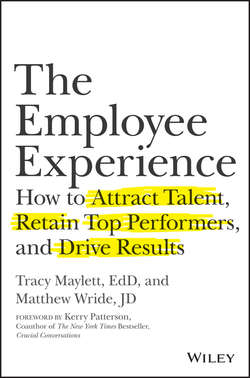Читать книгу The Employee Experience - Wride Matthew - Страница 4
На сайте Литреса книга снята с продажи.
Foreword
ОглавлениеWhen you ask employees how they approach their jobs, just over half of them say that they put in the least amount of work possible without getting fired. If this statistic is true, odds are the guy who recently assembled your grandfather’s pacemaker didn’t really care. One can only hope that surly pacemaker guy is actually part of the other half who are engaged in their work.
Until you understand who is putting in a full and smart effort each day – from producing pacemakers to driving Disney’s Jungle Boat (you try telling the same dumb jokes twenty times a day) – you don’t know where to focus your leadership attention. Who is fully engaged, but not in serving their customers – instead, they’re engaged in serving themselves? Consider the artists who design shampoo and conditioner labels. They work hard to produce a product that will win all kinds of art awards. Of course, that means they use small, grey fonts (they’re considered artsy and all the rage). Now, nobody over fifty who has the temerity to remove their glasses before entering the shower, can see the labels. Oh well, it’s just shampoo and conditioner. But what if the stakes were higher?
As you look behind the engagement headlines, you’re compelled to ask why so many people care so little about their work – or their customers. But you already know the answer, don’t you? It’s those darn Gen-Xers, Millennials, and other narcissists who are taking celebratory photos of themselves every time they chug a large soft drink or stand in front of a waterfall. When will people like that ever think about serving customers?
Perhaps we should look at this through a different lens. Maybe it’s not because of their age, and they weren’t simply born under the wrong star. It’s not because they’re selfish and lazy. There are dozens of factors that turn a job into, well, a job – and not a dream. If researchers could find those forces, and learn how to change them, leaders could move from complaining about low engagement to measuring and changing the experience. And, with a rise in employee engagement, so rises the customer experience.
That’s just what Tracy Maylett and Matthew Wride did. They plowed through tens of thousands of cases and millions of data points, figured out what actually tips the scale of engagement, and are now sharing what you can do to attract and retain top performing employees by building the right employee experience for your organization.
Good for them. For me, I’m taking away two things from this. First, based upon the marvelous research and catchy writing they displayed, Maylett and Wride were fully engaged in writing this book. It’s truly a work of passion. Second, I’m hoping that, when the day arrives, they can tell me the name of a fully engaged person who should build my pacemaker.
– Kerry Patterson
Coauthor of the New York Times bestseller
Crucial Conversations: Tools for Talking
When Stakes Are High
January 2017
